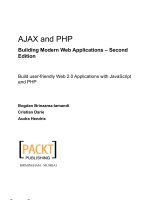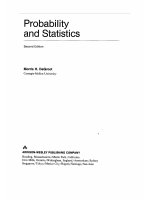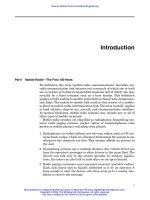- Trang chủ >>
- Khoa Học Tự Nhiên >>
- Vật lý
fractal geometry mathematical foundations and applications 2nd edition
Bạn đang xem bản rút gọn của tài liệu. Xem và tải ngay bản đầy đủ của tài liệu tại đây (3.45 MB, 361 trang )
FRACTAL
GEOMETRY
Mathematical Foundations
and Applications
FractalGeometry:MathematicalFoundationsandApplication. Second Edition Kenneth Falconer
2003 John Wiley & Sons, Ltd ISBNs: 0-470-84861-8 (HB); 0-470-84862-6 (PB)
FRACTAL
GEOMETRY
Mathematical Foundations
and Applications
Second Edition
Kenneth Falconer
University of St Andrews, UK
Copyright 2003 John Wiley & Sons Ltd, The Atrium, Southern Gate, Chichester,
West Sussex PO19 8SQ, England
Telephone (+44) 1243 779777
Email (for orders and customer service enquiries):
Visit our Home Page on www.wileyeurope.com or www.wiley.com
All Rights Reserved. No part of this publication may be reproduced, stored in a retrieval system or
transmitted in any form or by any means, electronic, mechanical, photocopying, recording,
scanning or otherwise, except under the terms of the Copyright, Designs and Patents Act 1988 or
under the terms of a licence issued by the Copyright Licensing Agency Ltd, 90 Tottenham Court
Road, London W1T 4LP, UK, without the permission in writing of the Publisher. Requests to the
Publisher should be addressed to the Permissions Department, John Wiley & Sons Ltd, The
Atrium, Southern Gate, Chichester, West Sussex PO19 8SQ, England, or emailed to
, or faxed to (+44) 1243 770620.
This publication is designed to provide accurate and authoritative information in regard to the
subject matter covered. It is sold on the understanding that the Publisher is not engaged in
rendering professional services. If professional advice or other expert assistance is required, the
services of a competent professional should be sought.
Other Wiley Editorial Offices
John Wiley & Sons Inc., 111 River Street, Hoboken, NJ 07030, USA
Jossey-Bass, 989 Market Street, San Francisco, CA 94103-1741, USA
Wiley-VCH Verlag GmbH, Boschstr. 12, D-69469 Weinheim, Germany
John Wiley & Sons Australia Ltd, 33 Park Road, Milton, Queensland 4064, Australia
John Wiley & Sons (Asia) Pte Ltd, 2 Clementi Loop #02-01, Jin Xing Distripark, Singapore 129809
John Wiley & Sons Canada Ltd, 22 Worcester Road, Etobicoke, Ontario, Canada M9W 1L1
Wiley also publishes its books in a variety of electronic formats. Some content that appears
in print may not be available in electronic books.
British Library Cataloguing in Publication Data
A catalogue record for this book is available from the British Library
ISBN 0-470-84861-8 (Cloth)
ISBN 0-470-84862-6 (Paper)
Typeset in 10/12pt Times by Laserwords Private Limited, Chennai, India
Printed and bound in Great Britain by TJ International, Padstow, Cornwall
This book is printed on acid-free paper responsibly manufactured from sustainable forestry
in which at least two trees are planted for each one used for paper production.
Contents
Preface ix
Preface to the second edition xiii
Course suggestions xv
Introduction xvii
Notes and references xxvii
PART I FOUNDATIONS 1
Chapter 1 Mathematical background 3
1.1 Basic set theory 3
1.2 Functions and limits 6
1.3 Measures and mass distributions 11
1.4 Notes on probability theory 17
1.5 Notes and references 24
Exercises 25
Chapter 2 Hausdorff measure and dimension 27
2.1 Hausdorff measure 27
2.2 Hausdorff dimension 31
2.3 Calculation of Hausdorff dimension—simple examples 34
*2.4 Equivalent definitions of Hausdorff dimension 35
*2.5 Finer definitions of dimension 36
2.6 Notes and references 37
Exercises 37
Chapter 3 Alternative definitions of dimension 39
3.1 Box-counting dimensions 41
3.2 Properties and problems of box-counting dimension 47
v
vi Contents
*3.3 Modified box-counting dimensions 49
*3.4 Packing measures and dimensions 50
3.5 Some other definitions of dimension 53
3.6 Notes and references 57
Exercises 57
Chapter 4 Techniques for calculating dimensions 59
4.1 Basic methods 59
4.2 Subsets of finite measure 68
4.3 Potential theoretic methods 70
*4.4 Fourier transform methods 73
4.5 Notes and references 74
Exercises 74
Chapter 5 Local structure of fractals 76
5.1 Densities 76
5.2 Structure of 1-sets 80
5.3 Tangents to
s
-sets 84
5.4 Notes and references 89
Exercises 89
Chapter 6 Projections of fractals 90
6.1 Projections of arbitrary sets 90
6.2 Projections of
s
-sets of integral dimension 93
6.3 Projections of arbitrary sets of integral dimension 95
6.4 Notes and references 97
Exercises 97
Chapter 7 Products of fractals 99
7.1 Product formulae 99
7.2 Notes and references 107
Exercises 107
Chapter 8 Intersections of fractals 109
8.1 Intersection formulae for fractals 110
*8.2 Sets with large intersection 113
8.3 Notes and references 118
Exercises 119
PART II APPLICATIONS AND EXAMPLES 121
Chapter 9 Iterated function systems—self-similar and self-affine sets 123
9.1 Iterated function systems 123
9.2 Dimensions of self-similar sets 128
vii
9.3 Some variations 135
9.4 Self-affine sets 139
9.5 Applications to encoding images 145
9.6 Notes and references 148
Exercises 149
Chapter 10 Examples from number theory 151
10.1 Distribution of digits of numbers 151
10.2 Continued fractions 153
10.3 Diophantine approximation 154
10.4 Notes and references 158
Exercises 158
Chapter 11 Graphs of functions 160
11.1 Dimensions of graphs 160
*11.2 Autocorrelation of fractal functions 169
11.3 Notes and references 173
Exercises 173
Chapter 12 Examples from pure mathematics 176
12.1 Duality and the Kakeya problem 176
12.2 Vitushkin’s conjecture 179
12.3 Convex functions 181
12.4 Groups and rings of fractional dimension 182
12.5 Notes and references 184
Exercises 185
Chapter 13 Dynamical systems 186
13.1 Repellers and iterated function systems 187
13.2 The logistic map 189
13.3 Stretching and folding transformations 193
13.4 The solenoid 198
13.5 Continuous dynamical systems 201
*13.6 Small divisor theory 205
*13.7 Liapounov exponents and entropies 208
13.8 Notes and references 211
Exercises 212
Chapter 14 Iteration of complex functions—Julia sets 215
14.1 General theory of Julia sets 215
14.2 Quadratic functions— the Mandelbrot set 223
14.3 Julia sets of quadratic functions 227
14.4 Characterization of quasi-circles by dimension 235
14.5 Newton’s method for solving polynomial equations 237
14.6 Notes and references 241
Exercises 242
viii Contents
Chapter 15 Random fractals 244
15.1 A random Cantor set 246
15.2 Fractal percolation 251
15.3 Notes and references 255
Exercises 256
Chapter 16 Brownian motion and Brownian surfaces 258
16.1 Brownian motion 258
16.2 Fractional Brownian motion 267
16.3 L
´
evy stable processes 271
16.4 Fractional Brownian surfaces 273
16.5 Notes and references 275
Exercises 276
Chapter 17 Multifractal measures 277
17.1 Coarse multifractal analysis 278
17.2 Fine multifractal analysis 283
17.3 Self-similar multifractals 286
17.4 Notes and references 296
Exercises 296
Chapter 18 Physical applications 298
18.1 Fractal growth 300
18.2 Singularities of electrostatic and gravitational potentials 306
18.3 Fluid dynamics and turbulence 307
18.4 Fractal antennas 309
18.5 Fractals in finance 311
18.6 Notes and references 315
Exercises 316
References 317
Index
329
Preface
I am frequently asked questions such as ‘What are fractals?’, ‘What is fractal
dimension?’, ‘How can one find the dimension of a fractal and what does it
tell us anyway?’ or ‘How can mathematics be applied to fractals?’ This book
endeavours to answer some of these questions.
The main aim of the book is to provide a treatment of the mathematics asso-
ciated with fractals and dimensions at a level which is reasonably accessible to
those who encounter fractals in mathematics or science. Although basically a
mathematics book, it attempts to provide an intuitive as well as a mathematical
insight into the subject.
The book falls naturally into two parts. Part I is concerned with the general
theory of fractals and their geometry. Firstly, various notions of dimension and
methods for their calculation are introduced. Then geometrical properties of frac-
tals are investigated in much the same way as one might study the geometry of
classical figures such as circles or ellipses: locally a circle may be approximated
by a line segment, the projection or ‘shadow’ of a circle is generally an ellipse,
a circle typically intersects a straight line segment in two points (if at all), and
so on. There are fractal analogues of such properties, usually with dimension
playing a key r
ˆ
ole. Thus we consider, for example, the local form of fractals,
and projections and intersections of fractals.
Part II of the book contains examples of fractals, to which the theory of the
first part may be applied, drawn from a wide variety of areas of mathematics
and physics. Topics include self-similar and self-affine sets, graphs of functions,
examples from number theory and pure mathematics, dynamical systems, Julia
sets, random fractals and some physical applications.
There are many diagrams in the text and frequent illustrative examples. Com-
puter drawings of a variety of fractals are included, and it is hoped that enough
information is provided to enable readers with a knowledge of programming to
produce further drawings for themselves.
It is hoped that the book will be a useful reference for researchers, providing
an accessible development of the mathematics underlying fractals and showing
how it may be applied in particular cases. The book covers a wide variety of
mathematical ideas that may be related to fractals, and, particularly in Part II,
ix
x Preface
provides a flavour of what is available rather than exploring any one subject
in too much detail. The selection of topics is to some extent at the author’s
whim—there are certainly some important applications that are not included.
Some of the material dates back to early in the twentieth century whilst some is
very recent.
Notes and references are provided at the end of each chapter. The references
are by no means exhaustive, indeed complete references on the variety of topics
covered would fill a large volume. However, it is hoped that enough information
is included to enable those who wish to do so to pursue any topic further.
It would be possible to use the book as a basis for a course on the mathe-
matics of fractals, at postgraduate or, perhaps, final-year undergraduate level, and
exercises are included at the end of each chapter to facilitate this. Harder sections
and proofs are marked with an asterisk, and may be omitted without interrupting
the development.
An effort has been made to keep the mathematics to a level that can be under-
stood by a mathematics or physics graduate, and, for the most part, by a diligent
final-year undergraduate. In particular, measure theoretic ideas have been kept to
a minimum, and the reader is encouraged to think of measures as ‘mass distribu-
tions’ on sets. Provided that it is accepted that measures with certain (intuitively
almost obvious) properties exist, there is little need for technical measure theory
in our development.
Results are always stated precisely to avoid the confusion which would other-
wise result. Our approach is generally rigorous, but some of the harder or more
technical proofs are either just sketched or omitted altogether. (However, a few
harder proofs that are not available in that form elsewhere have been included, in
particular those on sets with large intersection and on random fractals.) Suitable
diagrams can be a help in understanding the proofs, many of which are of a
geometric nature. Some diagrams are included in the book; the reader may find
it helpful to draw others.
Chapter 1 begins with a rapid survey of some basic mathematical concepts
and notation, for example, from the theory of sets and functions, that are used
throughout the book. It also includes an introductory section on measure theory
and mass distributions which, it is hoped, will be found adequate. The section
on probability theory may be helpful for the chapters on random fractals and
Brownian motion.
With the wide variety of topics covered it is impossible to be entirely consistent
in use of notation and inevitably there sometimes has to be a compromise between
consistency within the book and standard usage.
In the last few years fractals have become enormously popular as an art form,
with the advent of computer graphics, and as a model of a wide variety of physical
phenomena. Whilst it is possible in some ways to appreciate fractals with little or
no knowledge of their mathematics, an understanding of the mathematics that can
be applied to such a diversity of objects certainly enhances one’s appreciation.
The phrase ‘the beauty of fractals’ is often heard—it is the author’s belief that
much of their beauty is to be found in their mathematics.
Preface xi
It is a pleasure to acknowledge those who have assisted in the preparation
of this book. Philip Drazin and Geoffrey Grimmett provided helpful comments
on parts of the manuscript. Peter Shiarly gave valuable help with the computer
drawings and Aidan Foss produced some diagrams. I am indebted to Charlotte
Farmer, Jackie Cowling and Stuart Gale of John Wiley and Sons for overseeing
the production of the book.
Special thanks are due to David Marsh—not only did he make many useful
comments on the manuscript and produce many of the computer pictures, but he
also typed the entire manuscript in a most expert way.
Finally, I would like to thank my wife Isobel for her support and encourage-
ment, which extended to reading various drafts of the book.
Kenneth J. Falconer
Bristol, April 1989
Preface to the second edition
It is thirteen years since Fractal Geometry—Mathematical Foundations and Appli-
cations was first published. In the meantime, the mathematics and applications of
fractals have advanced enormously, with an ever-widening interest in the subject
at all levels. The book was originally written for those working in mathematics
and science who wished to know more about fractal mathematics. Over the past
few years, with changing interests and approaches to mathematics teaching, many
universities have introduced undergraduate and postgraduate courses on fractal
geometry, and a considerable number have been based on parts of this book.
Thus, this new edition has two main aims. First, it indicates some recent devel-
opments in the subject, with updated notes and suggestions for further reading.
Secondly, more attention is given to the needs of students using the book as a
course text, with extra details to help understanding, along with the inclusion of
further exercises.
Parts of the book have been rewritten. In particular, multifractal theory has
advanced considerably since the first edition was published, so the chapter on
‘Multifractal Measures’ has been completely rewritten. The notes and references
have been updated. Numerous minor changes, corrections and additions have
been incorporated, and some of the notation and terminology has been changed to
conform with what has become standard usage. Many of the diagrams have been
replaced to take advantage of the more sophisticated computer technology now
available. Where possible, the numbering of sections, equations and figures has
been left as in the first edition, so that earlier references to the book remain valid.
Further exercises have been added at the end of the chapters. Solutions to these
exercises and additional supplementary material may be found on the world wide
web at
/>In 1997 a sequel, Techniques in Fractal Geometry, was published, presenting
a variety of techniques and ideas current in fractal research. Readers wishing
to study fractal mathematics beyond the bounds of this book may find the
sequel helpful.
I am most grateful to all who have made constructive suggestions on the text. In
particular I am indebted to Carmen Fern
´
andez, Gwyneth Stallard and Alex Cain
xiii
xiv Preface to the second edition
for help with this revision. I am also very grateful for the continuing support
given to the book by the staff of John Wiley & Sons, and in particular to Rob
Calver and Lucy Bryan, for overseeing the production of this second edition and
John O’Connor and Louise Page for the cover design.
Kenneth J. Falconer
St Andrews, January 2003
Course suggestions
There is far too much material in this book for a standard length course on
fractal geometry. Depending on the emphasis required, appropriate sections may
be selected as a basis for an undergraduate or postgraduate course.
A course for mathematics students could be based on the following sections.
(a) Mathematical background
1.1 Basic set theory; 1.2 Functions and limits; 1.3 Measures and mass
distributions.
(b) Box-counting dimensions
3.1 Box-counting dimensions; 3.2 Properties of box-counting dimensions.
(c) Hausdorff measures and dimension
2.1 Hausdorff measure; 2.2 Hausdorff dimension; 2.3 Calculation of Haus-
dorff dimension; 4.1 Basic methods of calculating dimensions.
(d) Iterated function systems
9.1 Iterated function systems; 9.2 Dimensions of self-similar sets; 9.3 Some
variations; 10.2 Continued fraction examples.
(e) Graphs of functions
11.1 Dimensions of graphs, the Weierstrass function and self-affine graphs.
(f) Dynamical systems
13.1 Repellers and iterated function systems; 13.2 The logistic map.
(g) Iteration of complex functions
14.1 Sketch of general theory of Julia sets; 14.2 The Mandelbrot set; 14.3
Julia sets of quadratic functions.
xv
Introduction
In the past, mathematics has been concerned largely with sets and functions to
which the methods of classical calculus can be applied. Sets or functions that
are not sufficiently smooth or regular have tended to be ignored as ‘pathological’
and not worthy of study. Certainly, they were regarded as individual curiosities
and only rarely were thought of as a class to which a general theory might be
applicable.
In recent years this attitude has changed. It has been realized that a great deal
can be said, and is worth saying, about the mathematics of non-smooth objects.
Moreover, irregular sets provide a much better representation of many natural
phenomena than do the figures of classical geometry. Fractal geometry provides
a general framework for the study of such irregular sets.
We begin by looking briefly at a number of simple examples of fractals, and
note some of their features.
The middle third Cantor set is one of the best known and most easily con-
structed fractals; nevertheless it displays many typical fractal characteristics. It
is constructed from a unit interval by a sequence of deletion operations; see
figure 0.1. Let E
0
be the interval [0, 1]. (Recall that [a, b] denotes the set of real
numbers x such that a
x b.) Let E
1
be the set obtained by deleting the mid-
dle third of E
0
,sothatE
1
consists of the two intervals [0,
1
3
]and[
2
3
, 1]. Deleting
the middle thirds of these intervals gives E
2
; thus E
2
comprises the four intervals
[0,
1
9
], [
2
9
,
1
3
], [
2
3
,
7
9
], [
8
9
, 1]. We continue in this way, with E
k
obtained by delet-
ing the middle third of each interval in E
k−1
. Thus E
k
consists of 2
k
intervals
each of length 3
−k
.Themiddle third Cantor set F consists of the numbers that
are in E
k
for all k; mathematically, F is the intersection
∞
k=0
E
k
. The Cantor
set F may be thought of as the limit of the sequence of sets E
k
as k tends to
infinity. It is obviously impossible to draw the set F itself, with its infinitesimal
detail, so ‘pictures of F ’ tend to be pictures of one of the E
k
, which are a good
approximation to F when k is reasonably large; see figure 0.1.
At first glance it might appear that we have removed so much of the interval
[0, 1] during the construction of F , that nothing remains. In fact, F is an infinite
(and indeed uncountable) set, which contains infinitely many numbers in every
neighbourhood of each of its points. The middle third Cantor set F consists
xvii
xviii Introduction
01
E
0
E
1
E
2
E
3
E
4
E
5
F
F
L
F
R
1
3
2
3
Figure 0.1 Construction of the middle third Cantor set F , by repeated removal of the
middle third of intervals. Note that F
L
and F
R
, the left and right parts of F , are copies
of F scaled by a factor
1
3
precisely of those numbers in [0, 1] whose base-3 expansion does not contain
the digit 1, i.e. all numbers a
1
3
−1
+ a
2
3
−2
+ a
3
3
−3
+···with a
i
= 0or2for
each i. To see this, note that to get E
1
from E
0
we remove those numbers with
a
1
= 1, to get E
2
from E
1
we remove those numbers with a
2
= 1, and so on.
We list some of the features of the middle third Cantor set F ;asweshallsee,
similar features are found in many fractals.
(i) F is self-similar. It is clear that the part of F in the interval [0,
1
3
]andthe
part of F in [
2
3
, 1] are both geometrically similar to F , scaled by a factor
1
3
. Again, the parts of F in each of the four intervals of E
2
are similar to
F but scaled by a factor
1
9
, and so on. The Cantor set contains copies of
itself at many different scales.
(ii) The set F has a ‘fine structure’; that is, it contains detail at arbitrarily
small scales. The more we enlarge the picture of the Cantor set, the more
gaps become apparent to the eye.
(iii) Although F has an intricate detailed structure, the actual definition of F
is very straightforward.
(iv) F is obtained by a recursive procedure. Our construction consisted of
repeatedly removing the middle thirds of intervals. Successive steps give
increasingly good approximations E
k
to the set F .
(v) The geometry of F is not easily described in classical terms: it is not the
locus of the points that satisfy some simple geometric condition, nor is it
the set of solutions of any simple equation.
(vi) It is awkward to describe the local geometry of F —near each of its points
are a large number of other points, separated by gaps of varying lengths.
(vii) Although F is in some ways quite a large set (it is uncountably infinite),
its size is not quantified by the usual measures such as length—by any
reasonable definition F has length zero.
Our second example, the von Koch curve, will also be familiar to many readers;
seefigure0.2.WeletE
0
be a line segment of unit length. The set E
1
consists of
the four segments obtained by removing the middle third of E
0
and replacing it
Introduction xix
E
0
E
1
E
2
F
E
3
(a)
(b)
Figure 0.2 (a) Construction of the von Koch curve F . At each stage, the middle third of
each interval is replaced by the other two sides of an equilateral triangle. (b) Three von
Koch curves fitted together to form a snowflake curve
by the other two sides of the equilateral triangle based on the removed segment.
We construct E
2
by applying the same procedure to each of the segments in E
1
,
and so on. Thus E
k
comes from replacing the middle third of each straight line
segment of E
k−1
by the other two sides of an equilateral triangle. When k is
xx Introduction
large, the curves E
k−1
and E
k
differ only in fine detail and as k tends to infinity,
the sequence of polygonal curves E
k
approaches a limiting curve F , called the
von Koch curve.
The von Koch curve has features in many ways similar to those listed for
the middle third Cantor set. It is made up of four ‘quarters’ each similar to the
whole, but scaled by a factor
1
3
. The fine structure is reflected in the irregularities
at all scales; nevertheless, this intricate structure stems from a basically simple
construction. Whilst it is reasonable to call F a curve, it is much too irregular
to have tangents in the classical sense. A simple calculation shows that E
k
is of
length
4
3
k
; letting k tend to infinity implies that F has infinite length. On the
other hand, F occupies zero area in the plane, so neither length nor area provides
a very useful description of the size of F.
Many other sets may be constructed using such recursive procedures. For
example, the Sierpi´nski triangle or gasket is obtained by repeatedly removing
(inverted) equilateral triangles from an initial equilateral triangle of unit side-
length; see figure 0.3. (For many purposes, it is better to think of this procedure
as repeatedly replacing an equilateral triangle by three triangles of half the height.)
A plane analogue of the Cantor set, a ‘Cantor dust’, is illustrated in figure 0.4. At
each stage each remaining square is divided into 16 smaller squares of which four
are kept and the rest discarded. (Of course, other arrangements or numbers of
squares could be used to get different sets.) It should be clear that such examples
have properties similar to those mentioned in connection with the Cantor set and
the von Koch curve. The example depicted in figure 0.5 is constructed using two
different similarity ratios.
There are many other types of construction, some of which will be discussed
in detail later in the book, that also lead to sets with these sorts of properties.
E
0
E
1
F
E
2
Figure 0.3 Construction of the Sierpi
´
nski triangle (dim
H
F = dim
B
F = log 3/ log 2)
Introduction xxi
E
0
E
1
F
E
2
Figure 0.4 Construction of a ‘Cantor dust’ (dim
H
F = dim
B
F = 1)
E
0
E
1
F
E
2
Figure 0.5 Construction of a self-similar fractal with two different similarity ratios
xxii Introduction
The highly intricate structure of the Julia set illustrated in figure 0.6 stems from
the single quadratic function f(z)= z
2
+ c for a suitable constant c. Although
the set is not strictly self-similar in the sense that the Cantor set and von Koch
curve are, it is ‘quasi-self-similar’ in that arbitrarily small portions of the set can
be magnified and then distorted smoothly to coincide with a large part of the set.
Figure 0.7 shows the graph of the function f(t)=
∞
k=0
(
3
2
)
−k/2
sin((
3
2
)
k
t);the
infinite summation leads to the graph having a fine structure, rather than being a
smooth curve to which classical calculus is applicable.
Some of these constructions may be ‘randomized’. Figure 0.8 shows a ‘random
von Koch curve’—a coin was tossed at each step in the construction to determine
on which side of the curve to place the new pair of line segments. This random
curve certainly has a fine structure, but the strict self-similarity of the von Koch
curve has been replaced by a ‘statistical self-similarity’.
These are all examples of sets that are commonly referred to as fractals. (The
word ‘fractal’ was coined by Mandelbrot in his fundamental essay from the Latin
fractus, meaning broken, to describe objects that were too irregular to fit into a
traditional geometrical setting.) Properties such as those listed for the Cantor set
are characteristic of fractals, and it is sets with such properties that we will have
in mind throughout the book. Certainly, any fractal worthy of the name will
have a fine structure, i.e. detail at all scales. Many fractals have some degree of
self-similarity—they are made up of parts that resemble the whole in some way.
Sometimes, the resemblance may be weaker than strict geometrical similarity;
for example, the similarity may be approximate or statistical.
Methods of classical geometry and calculus are unsuited to studying frac-
tals and we need alternative techniques. The main tool of fractal geometry
is dimension in its many forms. We are familiar enough with the idea that a
Figure 0.6 A Julia set
Introduction xxiii
3f (t)
2
1
0
−1
−2
−3
0123456
t
Figure 0.7 Graph of f(t) =
∞
k=0
(
3
2
)
−k/2
sin((
3
2
)
k
t)
(smooth) curve is a 1-dimensional object and a surface is 2-dimensional. It is
less clear that, for many purposes, the Cantor set should be regarded as having
dimension log 2/ log 3 = 0.631 and the von Koch curve as having dimen-
sion log 4/ log 3 = 1.262 This latter number is, at least, consistent with the
von Koch curve being ‘larger than 1-dimensional’ (having infinite length) and
‘smaller than 2-dimensional’ (having zero area).
Figure 0.8 A random version of the von Koch curve
xxiv Introduction
(a)
(b)
(c)
(d)
Figure 0.9 Division of certain sets into four parts. The parts are similar to the whole with
ratios:
1
4
for line segment (a);
1
2
for square (b);
1
9
for middle third Cantor set (c);
1
3
for
von Koch curve (d)
The following argument gives one (rather crude) interpretation of the meaning
of these ‘dimensions’ indicating how they reflect scaling properties and self-
similarity. As figure 0.9 indicates, a line segment is made up of four copies of
itself, scaled by a factor
1
4
. The segment has dimension −log 4/ log
1
4
= 1. A
square, however, is made up of four copies of itself scaled by a factor
1
2
(i.e.
with half the side length) and has dimension −log 4/ log
1
2
= 2.Inthesameway,
the von Koch curve is made up of four copies of itself scaled by a factor
1
3
,and
has dimension −log 4/ log
1
3
= log 4/ log 3, and the Cantor set may be regarded
as comprising four copies of itself scaled by a factor
1
9
and having dimension
−log 4/ log
1
9
= log 2/ log 3. In general, a set made up of m copies of itself scaled
by a factor r might be thought of as having dimension −log m/ log r. The number
obtained in this way is usually referred to as the similarity dimension of the set.
Unfortunately, similarity dimension is meaningful only for a relatively small
class of strictly self-similar sets. Nevertheless, there are other definitions of
dimension that are much more widely applicable. For example, Hausdorff dimen-
sion and the box-counting dimensions may be defined for any sets, and, in
these four examples, may be shown to equal the similarity dimension. The early
chapters of the book are concerned with the definition and properties of Hausdorff
and other dimensions, along with methods for their calculation. Very roughly, a
dimension provides a description of how much space a set fills. It is a measure of
the prominence of the irregularities of a set when viewed at very small scales. A
dimension contains much information about the geometrical properties of a set.
A word of warning is appropriate at this point. It is possible to define the
‘dimension’ of a set in many ways, some satisfactory and others less so. It
is important to realize that different definitions may give different values of
Introduction xxv
dimension for the same set, and may also have very different properties. Incon-
sistent usage has sometimes led to considerable confusion. In particular, warning
lights flash in my mind (as in the minds of other mathematicians) whenever the
term ‘fractal dimension’ is seen. Though some authors attach a precise meaning
to this, I have known others interpret it inconsistently in a single piece of work.
The reader should always be aware of the definition in use in any discussion.
In his original essay, Mandelbrot defined a fractal to be a set with Haus-
dorff dimension strictly greater than its topological dimension. (The topological
dimension of a set is always an integer and is 0 if it is totally disconnected, 1 if
each point has arbitrarily small neighbourhoods with boundary of dimension 0,
and so on.) This definition proved to be unsatisfactory in that it excluded a num-
ber of sets that clearly ought to be regarded as fractals. Various other definitions
have been proposed, but they all seem to have this same drawback.
My personal feeling is that the definition of a ‘fractal’ should be regarded in
the same way as a biologist regards the definition of ‘life’. There is no hard and
fast definition, but just a list of properties characteristic of a living thing, such
as the ability to reproduce or to move or to exist to some extent independently
of the environment. Most living things have most of the characteristics on the
list, though there are living objects that are exceptions to each of them. In the
same way, it seems best to regard a fractal as a set that has properties such
as those listed below, rather than to look for a precise definition which will
almost certainly exclude some interesting cases. From the mathematician’s point
of view, this approach is no bad thing. It is difficult to avoid developing properties
of dimension other than in a way that applies to ‘fractal’ and ‘non-fractal’ sets
alike. For ‘non-fractals’, however, such properties are of little interest—they are
generally almost obvious and could be obtained more easily by other methods.
When we refer to a set F as a fractal, therefore, we will typically have the
following in mind.
(i) F has a fine structure, i.e. detail on arbitrarily small scales.
(ii) F is too irregular to be described in traditional geometrical language, both
locally and globally.
(iii) Often F has some form of self-similarity, perhaps approximate or statis-
tical.
(iv) Usually, the ‘fractal dimension’ of F (defined in some way) is greater
than its topological dimension.
(v) In most cases of interest F is defined in a very simple way, perhaps
recursively.
What can we say about the geometry of as diverse a class of objects as frac-
tals? Classical geometry gives us a clue. In Part I of this book we study certain
analogues of familiar geometrical properties in the fractal situation. The orthog-
onal projection, or ‘shadow’ of a circle in space onto a plane is, in general, an
ellipse. The fractal projection theorems tell us about the ‘shadows’ of a fractal.
For many purposes, a tangent provides a good local approximation to a circle.









